Technology Review of Magic School AI: An Intelligent Way for Education Inclusivity and Teacher Workload Reduction
Abstract
1. Product at a Glance
2. Introduction
3. Literature Review
4. Results
4.1. Potential Benefits and Implications of Magic School AI
4.2. Support Modification
Text Levelers
4.3. Support Scaffolding and Access
Assignment Scaffolder
4.4. Support Accommodation
4.4.1. Sentence Starters
4.4.2. Text Scaffolder
4.5. Supports Access and Comprehension
4.5.1. Exemplar & Non-Exemplar
4.5.2. Follow-Up Question
5. Summary of MSAI Features
6. Limitations and Implications
7. Conclusions and Suggestions
- The Magic School AI may categorize the functions to be more user-friendly. The MSAI has embedded many functions, and teachers need to spend a lot of time locating the function(s) they want. It may be helpful if MSAI categorizes these functions as Special education, Math, ELA, parent communication, school reports, teaching tools, etc.
- It would be beneficial if Magic School AI could create tutorial videos to guide teachers with all the functions. This tutorial can serve as a mini professional development for teachers and help them understand how AI can ease their workload, create more accessible learning for all, etc.
- The Magic School AI could develop a more intellectual lesson plan modification system. The current functions generate broad modifications and accommodations. Teachers are still determining whether the lesson is inclusive enough for students with IEPs. If teachers can upload their lesson plans and receive direct feedback, modifications, and accommodations, they will be more confident in delivering their lessons effectively and efficiently.
Author Contributions
Funding
Data Availability Statement
Conflicts of Interest
References
- Acquah, B., Arthur, F., Salifu, I., Quayson, E., & Nortey, S. (2024). Preservice teachers’ behavioural intention to use artificial intelligence in lesson planning: A dual-staged PLS-SEM-ANN approach. Computer Education: Artificial Intelligence, 7, 100307. [Google Scholar] [CrossRef]
- Amzil, I., Aammou, S., & Zakaria, T. (2023). Enhances’ learning by providing personalized study pathways. Conhecimento & Diversidade, 15. [Google Scholar] [CrossRef]
- Ballhysa, N., & Flagler, M. (2011). A teachers’ perspective of inclusive education for students with special needs in a model demonstration project. Academicus: International Scientific Journal, 3, 121–133. [Google Scholar] [CrossRef]
- Begeske, J., Lory, C., David, M., & Rispoli, M. (2023). Teacher education and students with disabilities in art class: A program evaluation. Arts Education Policy Review, 124(1), 48–60. [Google Scholar] [CrossRef]
- Burdick, C., & Causton-Theoharis, J. (2012). Creating effective paraprofessional support in the inclusive art classroom. Art Education, 65(6), 33–37. [Google Scholar] [CrossRef]
- Carr, B. (2023). Revolutionizing education: Unleashing the power of ChatGPT/AI to empower educators. Technology and the Curriculum: Summer 2023, 36, 77–84. [Google Scholar]
- Chu, M., Craig, H. L., Yeworiew, L., & Xu, Y. (2020). Teachers’ unpreparedness to accommodate student needs. Canadian Journal of School Psychology, 35, 210–224. [Google Scholar] [CrossRef]
- Cooc, N. (2019). Teaching students with special needs: International trends in school capacity and the need for teacher professional development. Teaching and Teacher Education, 83, 27–41. [Google Scholar] [CrossRef]
- Cuñado, A. G., & Abocejo, F. T. (2019). Lesson planning competency of English major university sophomore students. European Journal of Education Studies, 5(8), 395–408. [Google Scholar]
- Cutanda-López, M. T., & Alfageme-González, M. B. (2022). Teacher training to take care of students at risk of exclusion. Social Sciences, 11(12), 544. [Google Scholar] [CrossRef]
- Eisenman, L. T., Pleet, A. M., Wandry, D. L., & McGinley, V. A. (2011). Voices of special education teachers in an inclusive high school: Redefining responsibilities. Remedial and Special Education, 32, 104–191. [Google Scholar] [CrossRef]
- Gesel, S. A., Foreman-Murray, L., & Gilmour, A. F. (2021). Sufficiency of teachers’ access to resources and supports for students with disabilities. Teacher Education and Special Education, 45(2), 204–226. [Google Scholar] [CrossRef]
- Guay, D. M. (2003). Paraeducators in art classrooms: Issues of culture, leadership, and special needs. Studies in Art Education, 45(1), 20–39. [Google Scholar] [CrossRef]
- Hall, D. (2019). Lesson-planning. NT Learning Curve, 1(8), 4–5. [Google Scholar]
- Harrison, J. R., Bunford, N., Evans, S. W., & Owens, J. S. (2013). Educational accommodations for students with behavioral challenges: A systematic review of the literature. Review of Educational Research, 83(4), 551–597. [Google Scholar] [CrossRef]
- Jameson, J. M., & Huefner, D. S. (2006). “Highly qualified” special educators and the provision of a free appropriate public education to students with disabilities. The Journal of Law of Education, 35, 29. [Google Scholar]
- Janssen, N., & Lazonder, A. (2015). Implementing innovative technologies through lesson plans: What kind of support do teachers prefer? Journal of Science Education and Technology, 24, 910–920. [Google Scholar] [CrossRef]
- Kehoe, F. (2023). Leveraging generative AI tools for enhanced lesson planning in initial teacher education at post primary. Irish Journal of Technology Enhanced Learning, 7(2), 172–182. [Google Scholar] [CrossRef]
- Lampou, R. (2023). The integration of artificial intelligence in education: Opportunities and challenges. Review of Artificial Intelligence in Education, 4, e15. [Google Scholar] [CrossRef]
- Lee, H. (2010). To kill a mockingbird. Arrow Books Ltd. [Google Scholar]
- Lee, Y., & Takahashi, A. (2011). Lesson plans and the contingency of classroom interactions. Human Studies, 34, 209–227. [Google Scholar] [CrossRef]
- Lewandowski, L., Hendricks, K., & Gordon, M. S. (2015). Test-taking performance of high school students with ADHD. Journal of Attention Disorders, 19, 27–34. [Google Scholar] [CrossRef]
- Lim, W., Son, J. W., & Kim, D. J. (2018). Understanding preservice teacher skills to construct lesson plans. International Journal of Science and Mathematics Education, 16, 519–538. [Google Scholar] [CrossRef]
- Martínez, Y. M., & Porter, G. L. (2018). Planning for all students: Promoting inclusive instruction. International Journal of Inclusive Education, 24(14), 1552–1567. [Google Scholar] [CrossRef]
- McCabe, K. M., & Ruppar, A. L. (2023). Rural inclusive education for students with disabilities in the United States: A narrative review of research. Rural Educator, 44(1), 40–55. [Google Scholar] [CrossRef]
- Mollick, E., & Mollick, L. (2023). Using AI to implement effective teaching strategies in classrooms: Five strategies, including prompts. SSRN Electronic Journal. [Google Scholar] [CrossRef]
- Morgan, J. L. (2016). Reshaping the role of a special educator into a collaborative learning specialist. International Journal of Whole Schooling, 12(1), 40–60. [Google Scholar]
- Nguyen, T. T., Thuan, H. T., & Nguyen, M. T. (2023). Artificial intelligent (AI) in teaching and learning: A comprehensive review. In ISTES Books (pp. 140–161). ISTES Organization. [Google Scholar]
- Nichols, S. C., Bicard, S. C., Bicard, D. F., & Casey, L. B. (2008). A field at risk: The teacher shortage in special education. Phi Delta Kappan Magazine, 89, 597–600. [Google Scholar] [CrossRef]
- Özgüç, C. S., & Cavkaytar, A. (2015). Science education for students with intellectual disability: A case study. Journal of Baltic Science Education, 14(6), 804–820. [Google Scholar] [CrossRef]
- Paiz, J. M., Toncelli, R., & Kostka, I. (2025). Artificial intelligence, real teaching: A guide to AI in ELT. University of Michigan Press. [Google Scholar]
- Petera, P. A. (2023). 13 artificial intelligence tools for education: Exploring the new horizons for the teaching-learning process: Exploring new horizons. Available online: https://www.researchgate.net/profile/Vaibhav-Chauhan-6/publication/374059885_Exploring_New_Horizons_Multidiscipli-nary_Perspectives_in_Research_Volume_I/links/650bccc261f18040c20f6efb/Exploring-New-Horizons-Multidisciplinary-Perspectives-in-Research-Volume-I.pdf#page=86 (accessed on 10 November 2024).
- ReadingVine. (2022, November 1). Explanation: Printable 6th–9th grade reading activity. Available online: https://www.readingvine.com/passages/explanation/ (accessed on 10 November 2024).
- The Children’s Guild. (2024, May 9). Schools need special education teachers: Where are they going, and where are they coming from? Available online: https://childrensguild.org/schools-need-special-education-teachers-where-are-they-going-and-where-are-they-coming-from/ (accessed on 10 November 2024).
- Toplak, M. E., Rucklidge, J. J., Hetherington, R., John, S. C., & Tannock, R. (2003). Time perception deficits in attention-deficit/hyperactivity disorder and comorbid reading difficulties in child and adolescent samples. Journal of Child Psychology and Psychiatry, and Allied Disciplines, 44(6), 888–903. [Google Scholar] [CrossRef]
- Vannest, K., & Hagan-Burke, S. (2010). Teacher time use in special education. Remedial and Special Education, 31, 126–142. [Google Scholar] [CrossRef]
- Villanueva, M. G., Taylor, J., Therrien, W., & Hand, B. (2012). Science education for students with special needs. Studies in Science Education, 48(2), 187–215. [Google Scholar] [CrossRef]
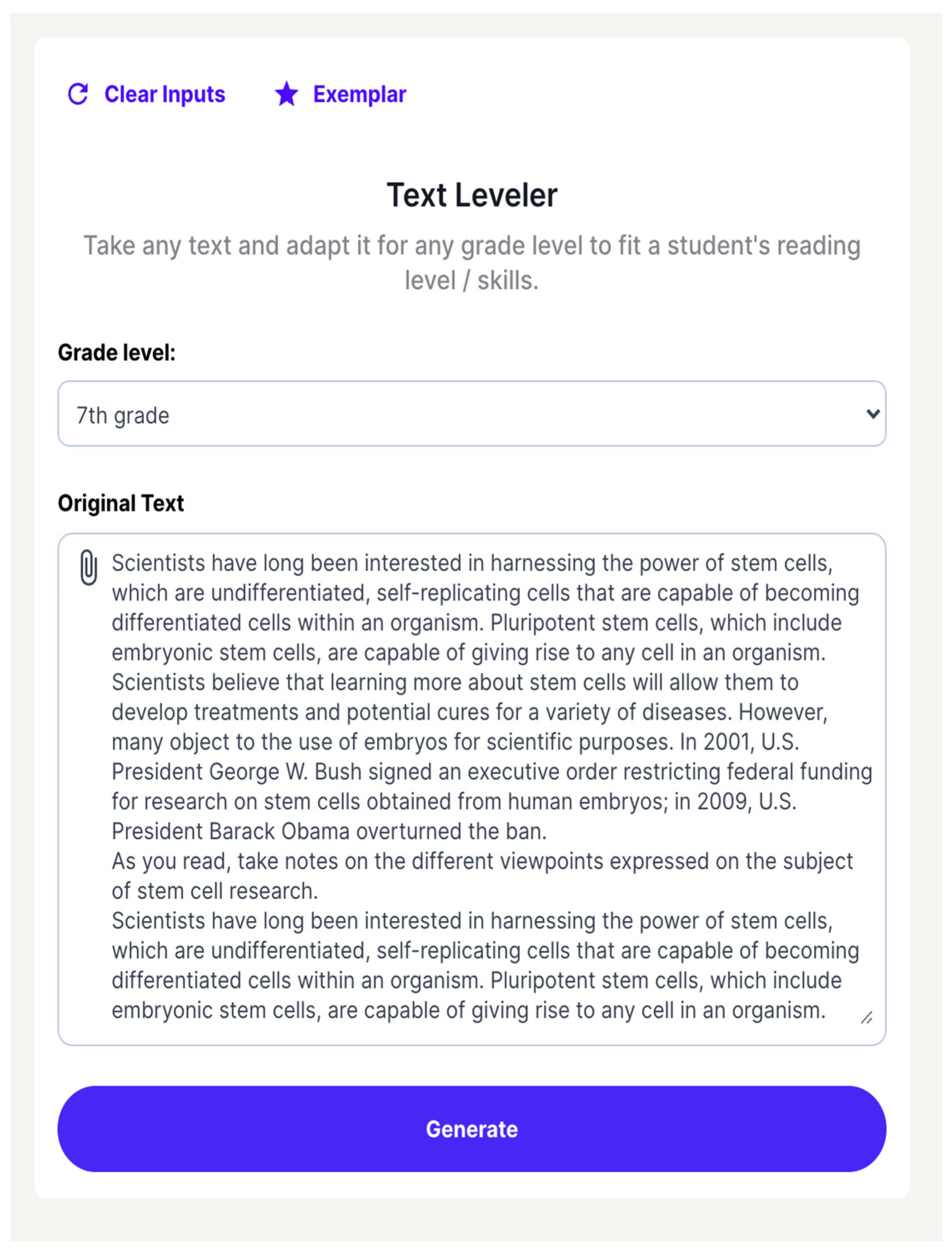
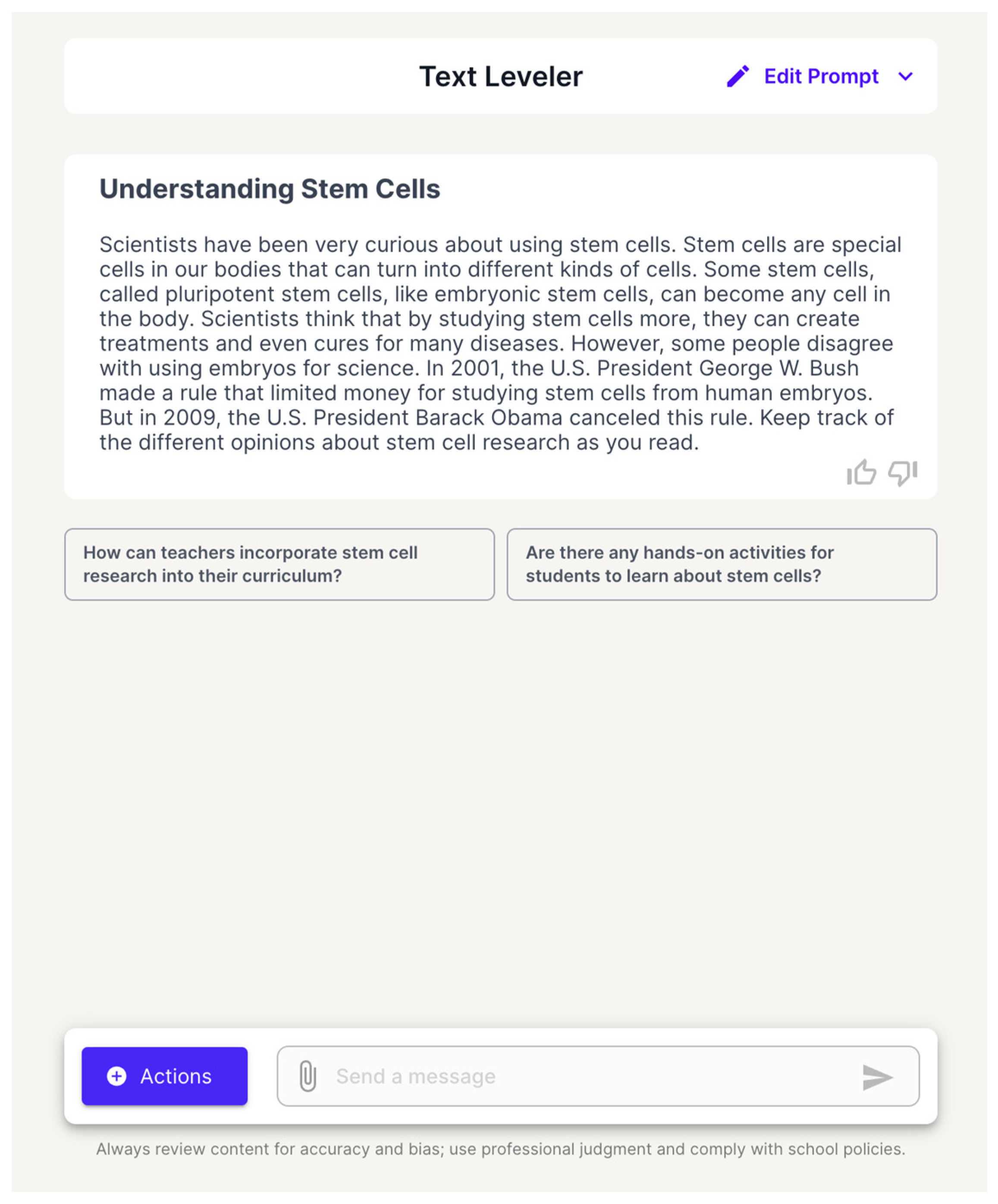
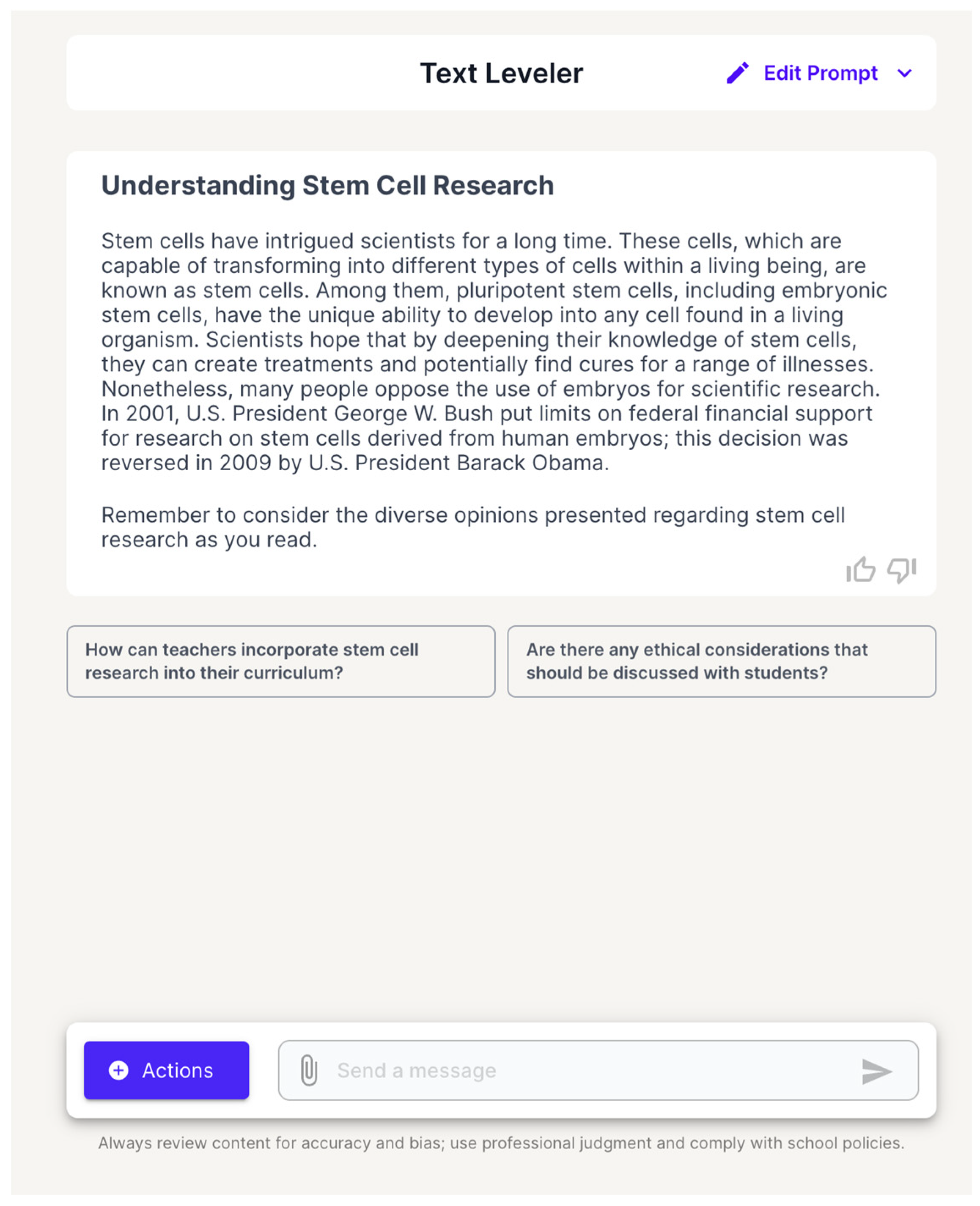

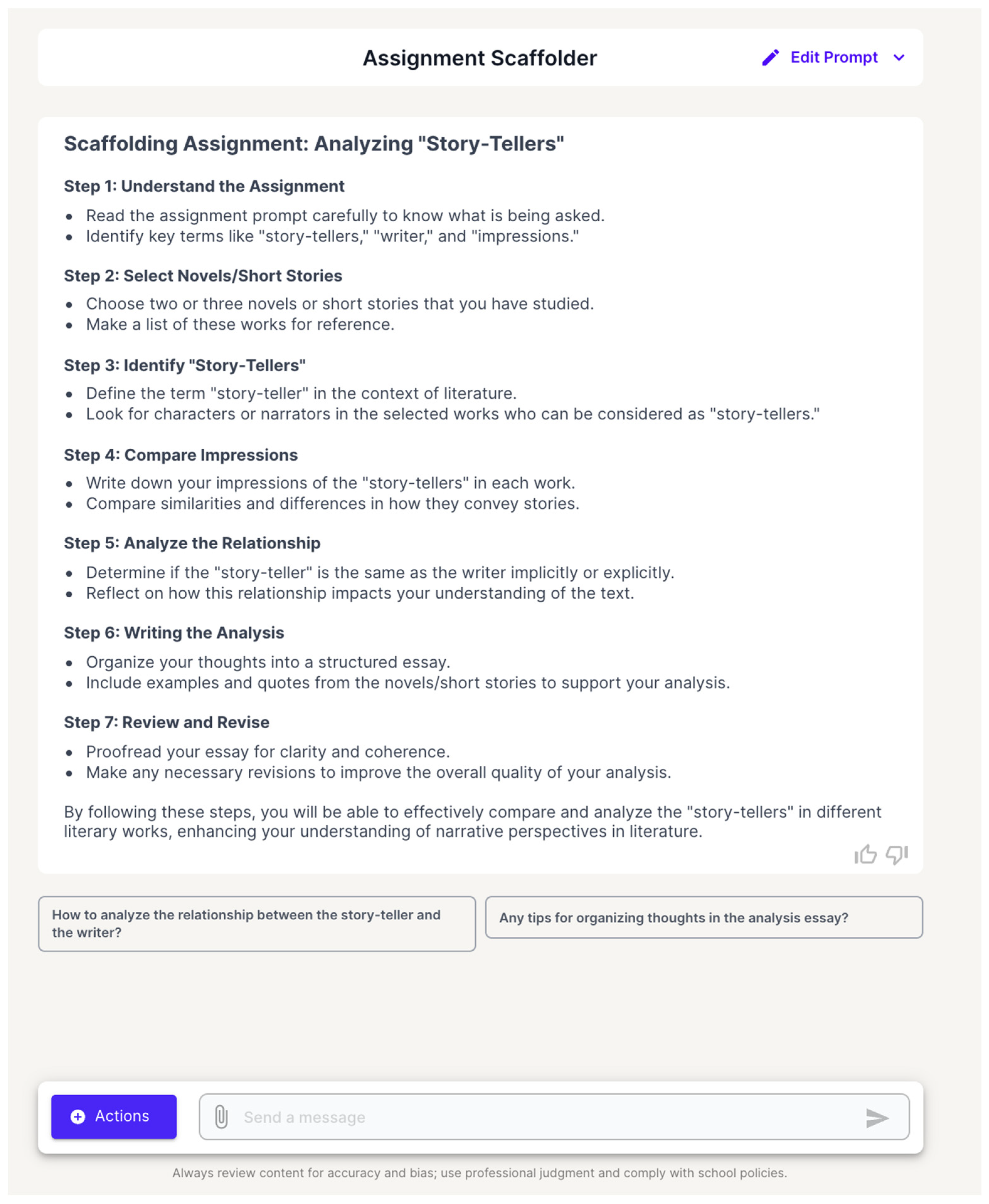


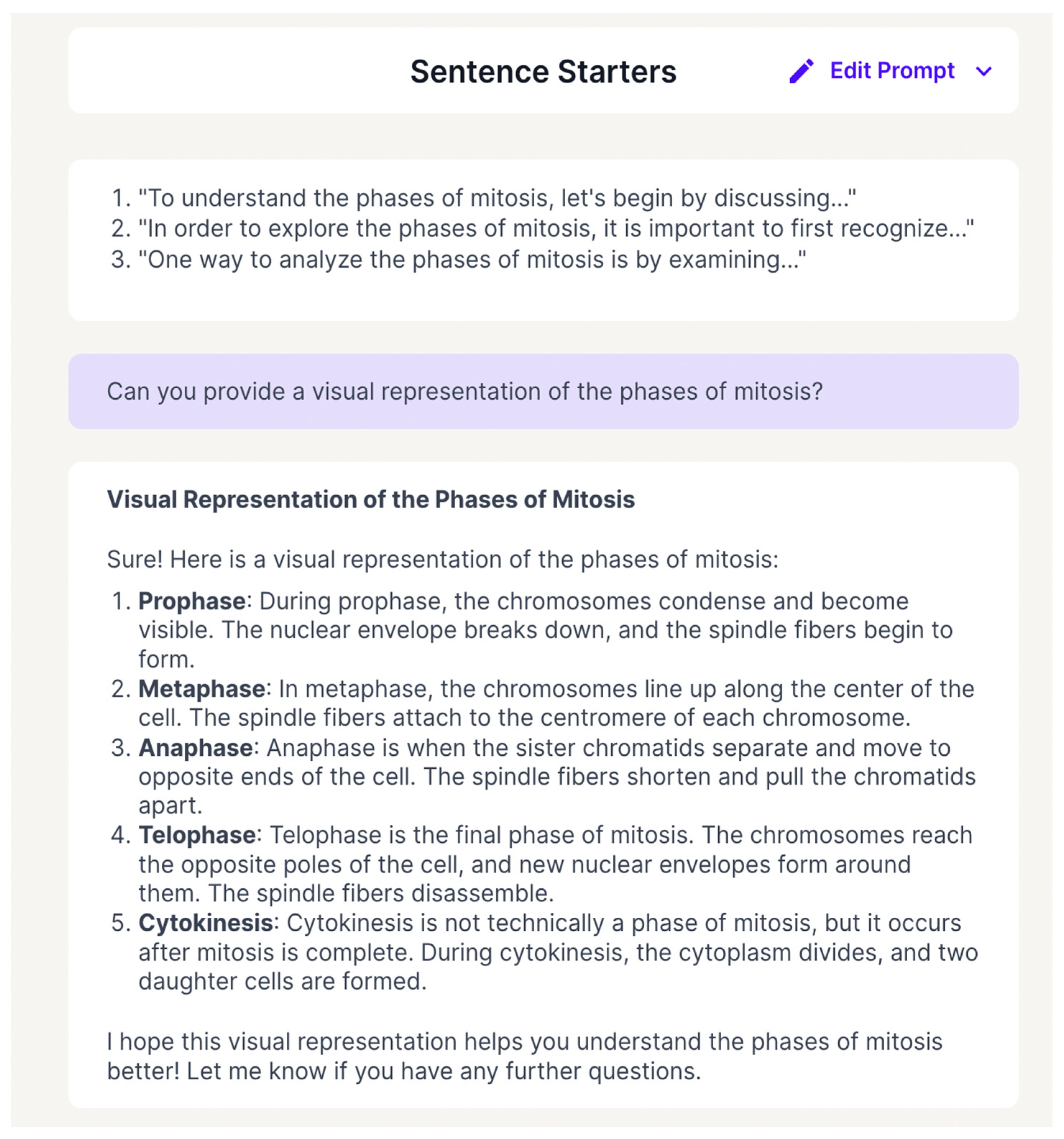
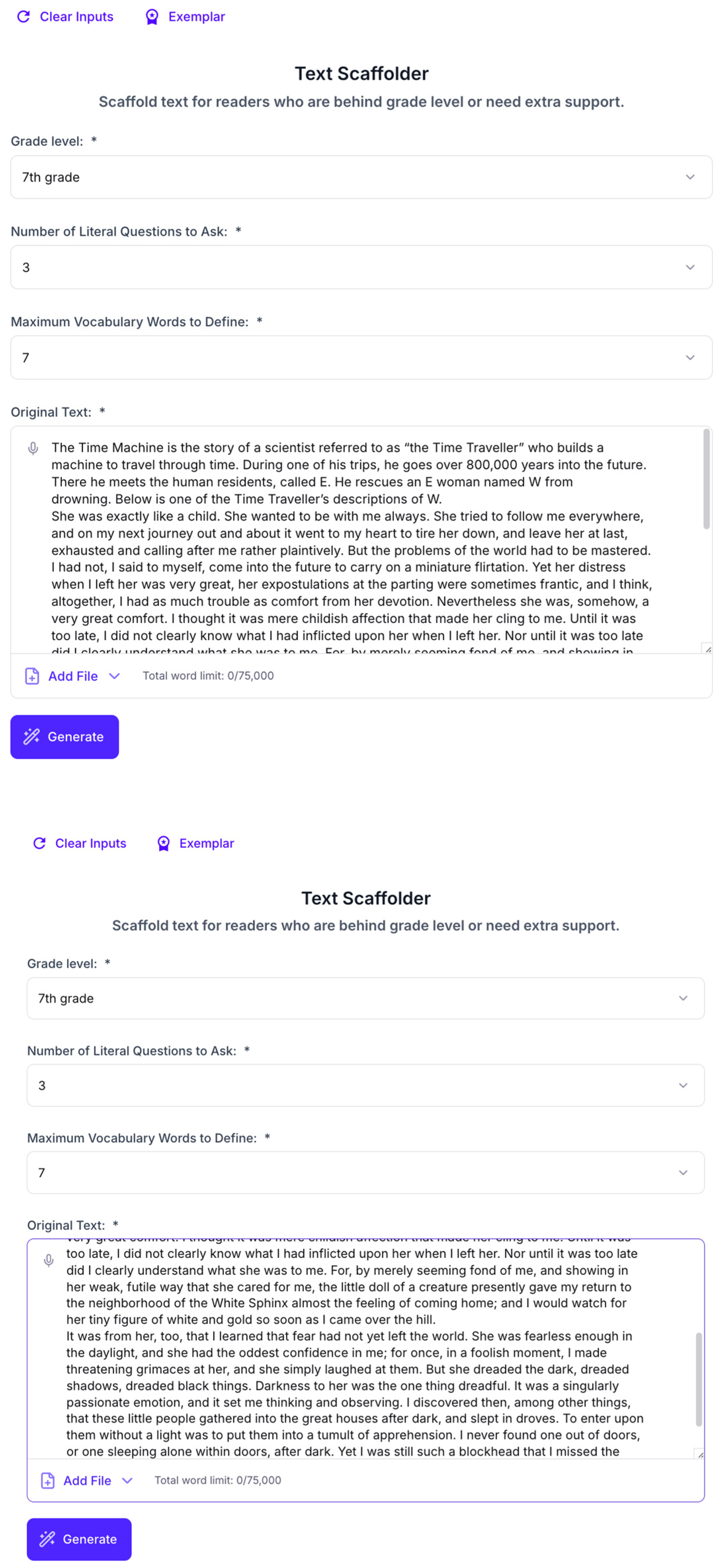
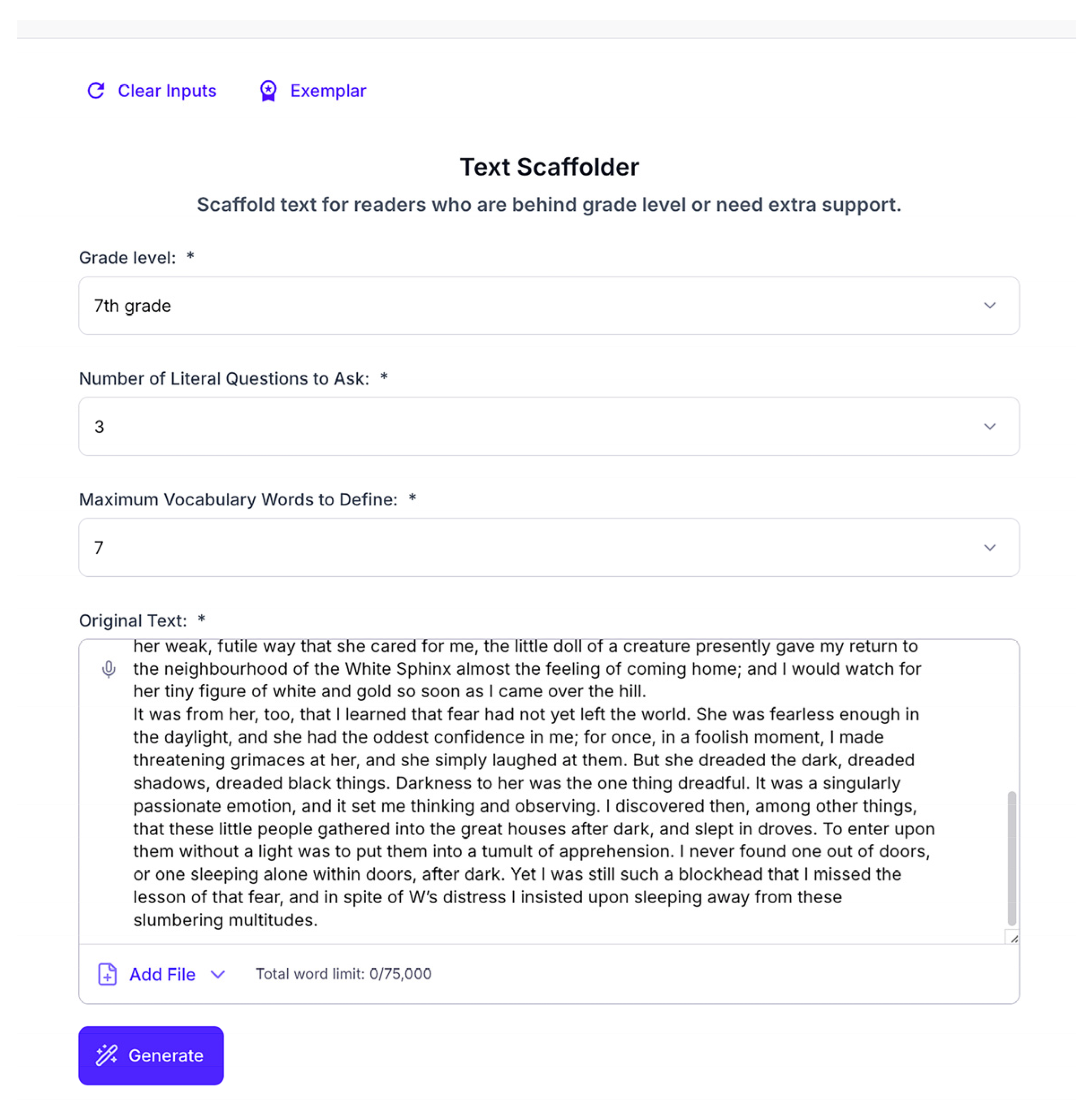


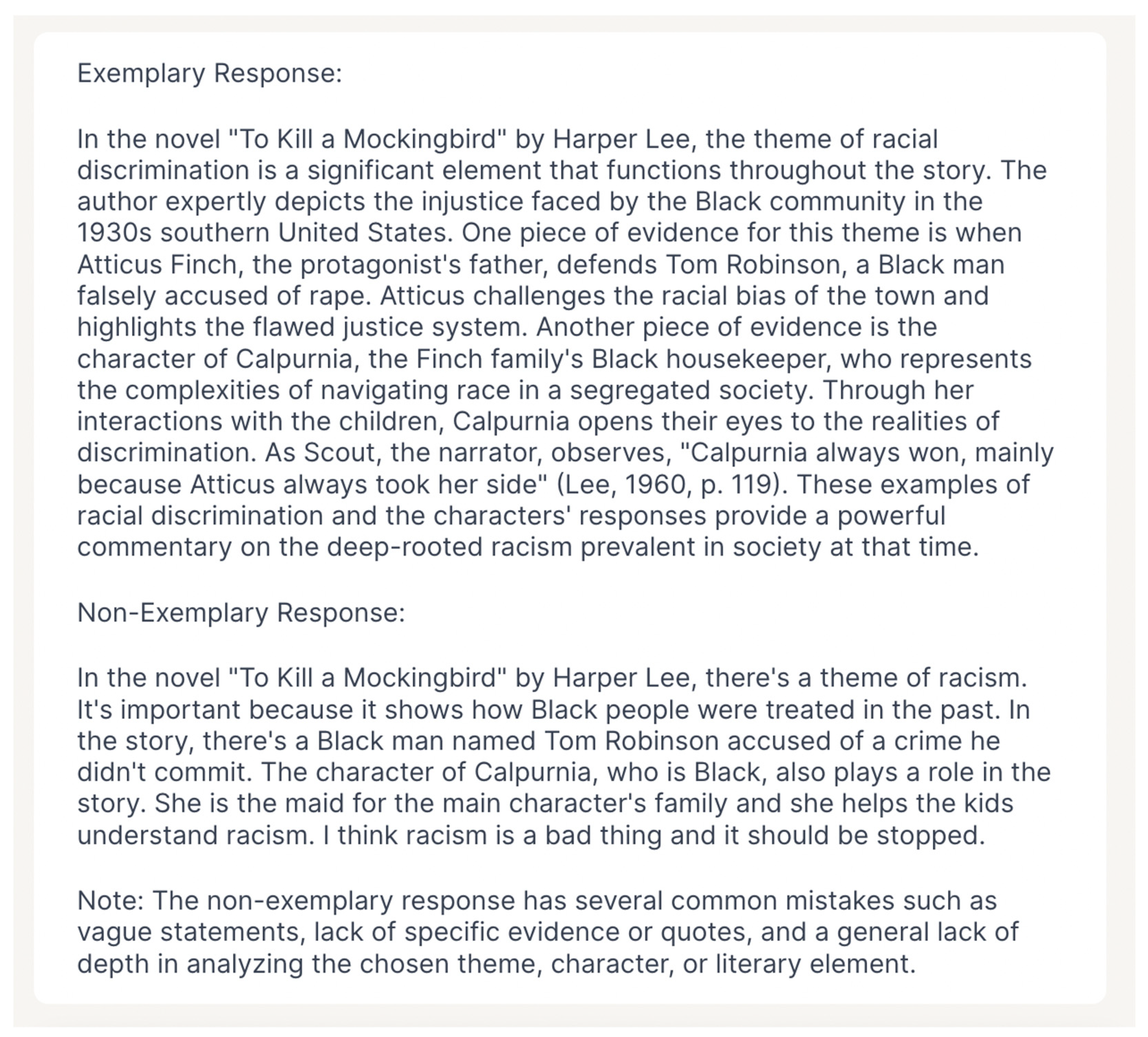

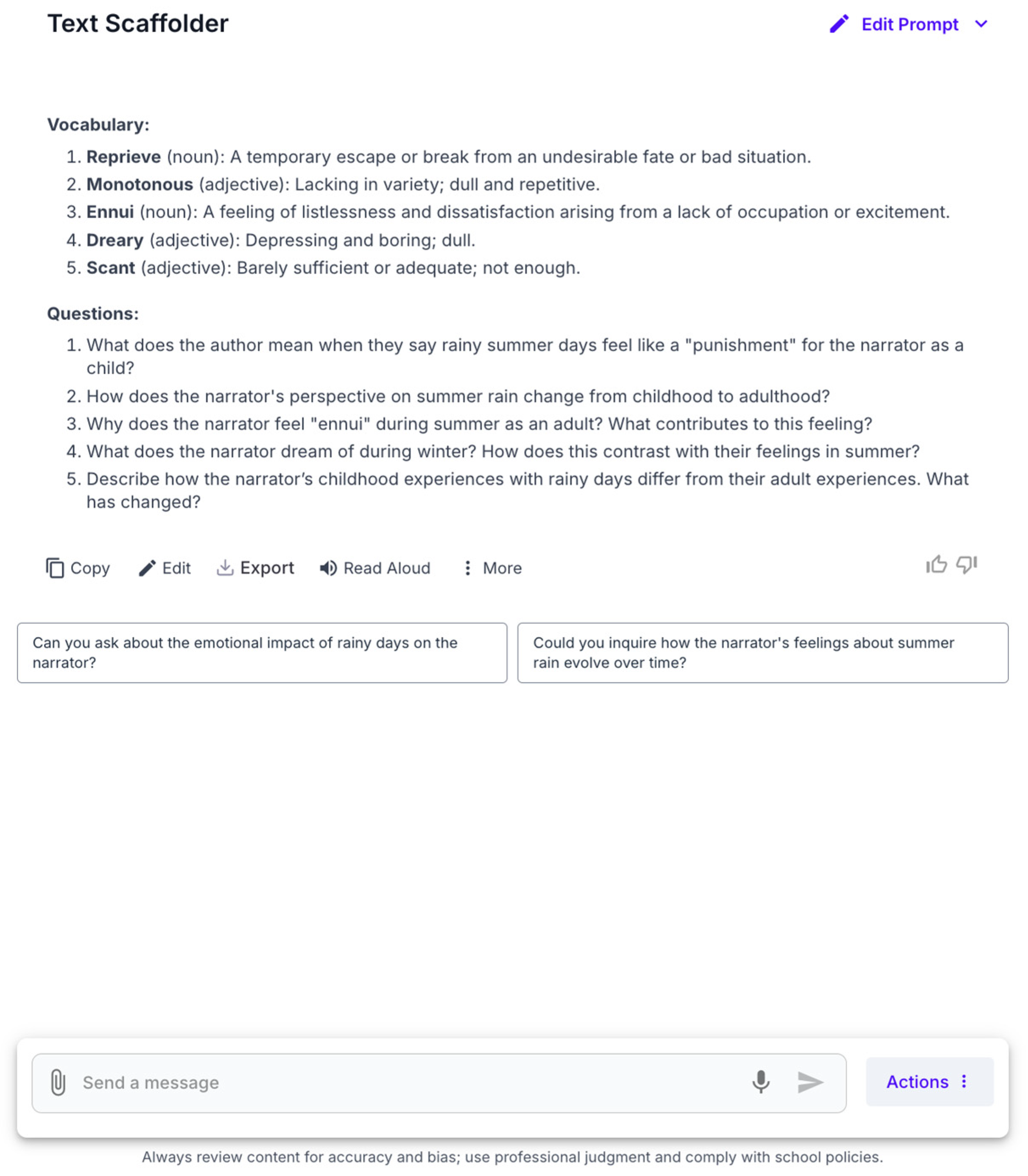
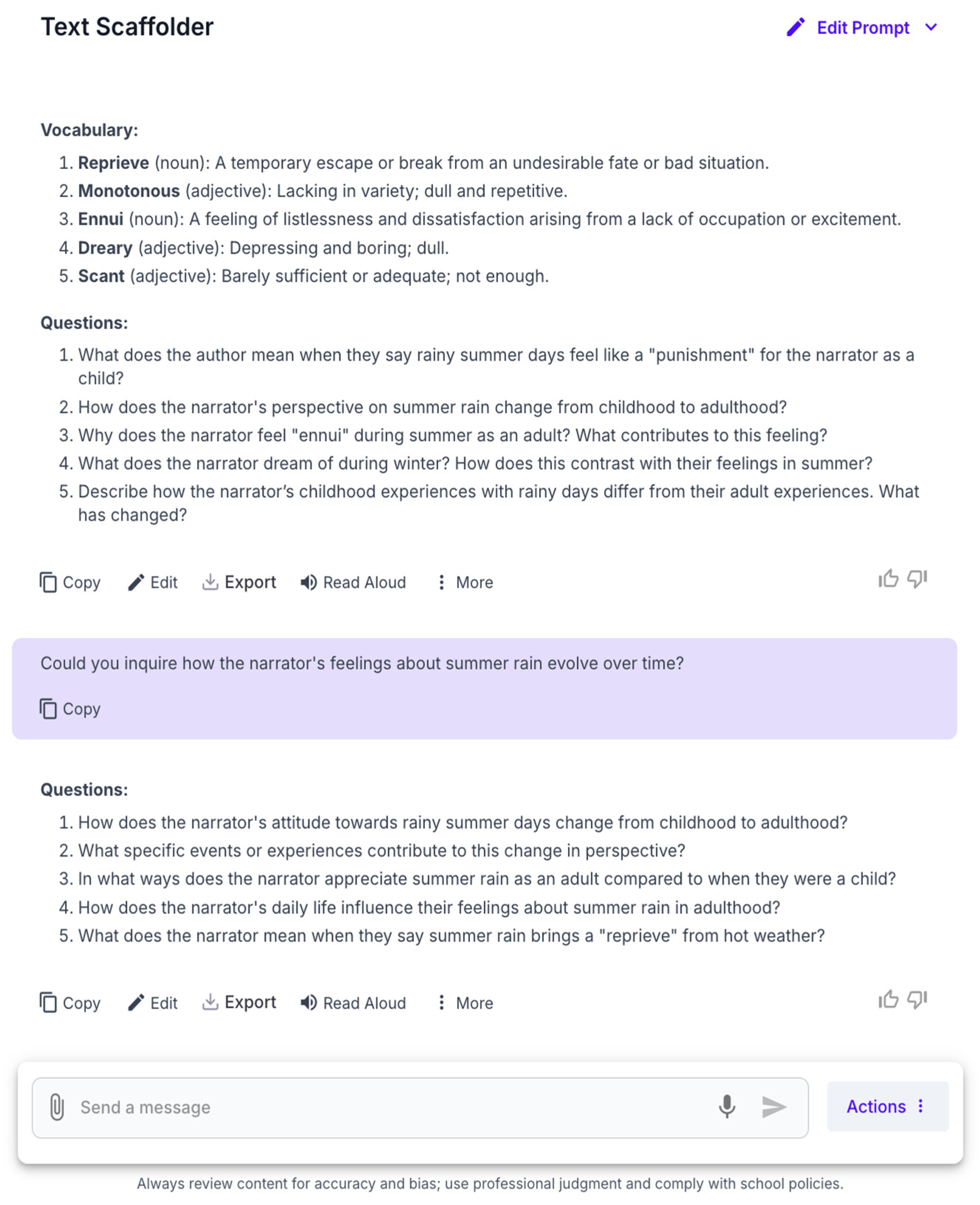

| Product Name | Magic School AI |
| Website | https://www.magicschool.ai/ (accessed on 17 June 2025) |
| Languages | English |
| Product Type | A web-based Artificial Intelligence Platform for teachers |
| Operating System | PC or Mac with Chrome or Safari |
| Hardware Requirements | A device can connect to the Internet |
| Price | Free |
| MSAI Feature | Pedagogical Function | Modification/Accommodation/Workload Reduction | Explanation |
|---|---|---|---|
| Text Leveler | Adjusts reading difficulty based on grade level | Modification Workload Reduction | Changes text complexity to fit students’ reading levels; saves teachers time rewriting materials. |
| Text Scaffolder | Defines vocabulary, generates guiding questions, shortens or explains texts | Accommodation Workload Reduction | Supports access to grade-level text without changing standards and is helpful for students with IEPs or ELLs. |
| Assignment Scaffolder | Breaks down multi-step assignments into manageable steps | Accommodation Workload Reduction | Helps students with executive functioning challenges follow complex tasks; saves planning time. |
| Exemplars & Non-Exemplars | Models strong and weak student work with explanations | Accommodation Workload Reduction | Clarifies expectations and reduces ambiguity for students who benefit from concrete examples. |
| Sentence Starters | Provides structured sentence stems for writing and academic tasks | Accommodation | Aids students who struggle with language production or organization. |
| Follow-up Questions | This is for an additional function for all features in MSAI | Workload Reduction | Individualized the content based on teachers needs |
Disclaimer/Publisher’s Note: The statements, opinions and data contained in all publications are solely those of the individual author(s) and contributor(s) and not of MDPI and/or the editor(s). MDPI and/or the editor(s) disclaim responsibility for any injury to people or property resulting from any ideas, methods, instructions or products referred to in the content. |
© 2025 by the authors. Licensee MDPI, Basel, Switzerland. This article is an open access article distributed under the terms and conditions of the Creative Commons Attribution (CC BY) license (https://creativecommons.org/licenses/by/4.0/).
Share and Cite
Li, X.; Li, B.; Li, J.; Cho, S.-J. Technology Review of Magic School AI: An Intelligent Way for Education Inclusivity and Teacher Workload Reduction. Educ. Sci. 2025, 15, 963. https://doi.org/10.3390/educsci15080963
Li X, Li B, Li J, Cho S-J. Technology Review of Magic School AI: An Intelligent Way for Education Inclusivity and Teacher Workload Reduction. Education Sciences. 2025; 15(8):963. https://doi.org/10.3390/educsci15080963
Chicago/Turabian StyleLi, Xiaying, Belle Li, Jianing Li, and Su-Je Cho. 2025. "Technology Review of Magic School AI: An Intelligent Way for Education Inclusivity and Teacher Workload Reduction" Education Sciences 15, no. 8: 963. https://doi.org/10.3390/educsci15080963
APA StyleLi, X., Li, B., Li, J., & Cho, S.-J. (2025). Technology Review of Magic School AI: An Intelligent Way for Education Inclusivity and Teacher Workload Reduction. Education Sciences, 15(8), 963. https://doi.org/10.3390/educsci15080963





